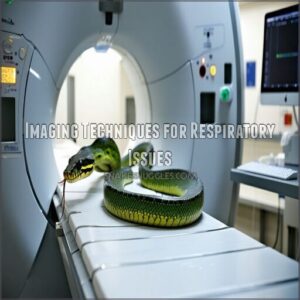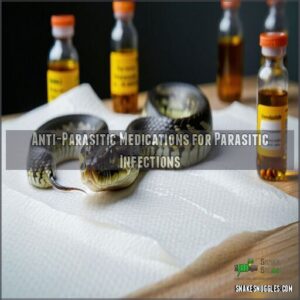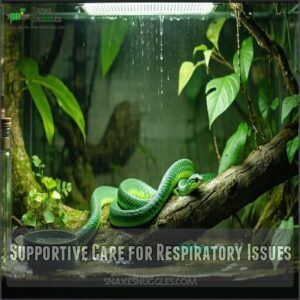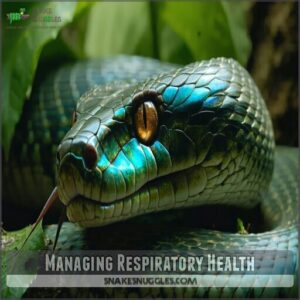This site is supported by our readers. We may earn a commission, at no cost to you, if you purchase through links.
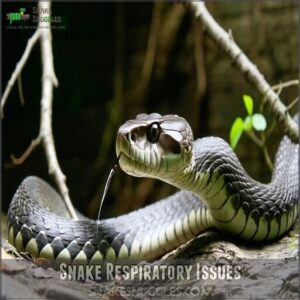
These problems often come from infections, improper humidity, or stress.
You might spot other warning signs like lethargy or poor appetite.
Snakes rely on stable environments, so fluctuating temperatures or dirty enclosures can tip the scales against their health.
Left unchecked, respiratory issues can spiral into severe infections.
Think prevention—clean enclosures, consistent temperatures, and vet check-ups.
Keep a close eye on your pet’s breathing; sometimes, the smallest hiss signals the biggest warning.
Table Of Contents
- Key Takeaways
- Snake Respiratory Issues
- Diagnosing Respiratory Issues
- Treating Respiratory Issues
- Preventing Respiratory Issues
- Managing Respiratory Health
- Frequently Asked Questions (FAQs)
- How to treat respiratory issues in snakes?
- What are 6 signs of respiratory infection?
- Do snakes have respiratory problems?
- What causes respiratory distress in snakes?
- Why do snakes have difficulty breathing?
- How to tell if a snake has a respiratory infection?
- How do you fix respiratory problems in snakes?
- Will snake respiratory infection go away on its own?
- Are snake respiratory infections contagious?
- How do snake respiratory systems function?
- Conclusion
Key Takeaways
- Keep your snake’s enclosure clean, with stable temperatures and proper humidity, to prevent respiratory issues.
- Watch for signs like wheezing, open-mouth breathing, and mucus around the nostrils, and act fast if you spot them.
- Consult a reptile vet for diagnosis and targeted treatment like antibiotics or antifungals; don’t wait for problems to resolve themselves.
- Quarantine new snakes, improve ventilation, and maintain regular check-ups to stop the spread of infections and detect issues early.
Snake Respiratory Issues
Your snake’s respiratory system is vulnerable to infections that can quickly become life-threatening if left untreated.
Snakes rely on attentive care; untreated respiratory infections can escalate rapidly, making early detection and veterinary support vital for their survival.
You’ll need to monitor for warning signs like wheezing, nasal discharge, or open-mouth breathing to guarantee prompt veterinary care.
Causes of Respiratory Infections
Five main culprits cause respiratory infections in snakes. Bacterial agents like Pseudomonas are most common, often generating excess mucus that blocks oxygen absorption.
Viral infections, such as nidovirus, can weaken your snake’s immune system. Fungal infections and parasitic causes (including roundworms) typically attack when a snake’s health is compromised.
If roundworms are suspected, consider appropriate snake parasite treatment. Non-infectious causes like improper temperature or humidity can also trigger respiratory issues.
Symptoms of Respiratory Distress
Vigilance can save your snake‘s life when respiratory distress strikes.
Watch for these warning signs:
- Open-mouth breathing or gaping, often with neck stretched upward
- Nasal discharge that may appear clear or cloudy
- Wheezing sounds during breathing, sometimes audible from across the room
- Lethargy signs including unusual inactivity and hiding
- Anorexia impact resulting in refusal to eat for extended periods
Risk Factors for Respiratory Infections
Several key factors can put your snake at risk for respiratory infections. Poor enclosure conditions—especially inadequate temperature, excessive humidity, or poor ventilation—are primary environmental stressors.
Immune suppression from stress, improper nutrition, or handling can increase vulnerability. Genetic predisposition plays a role in certain species, with Boidae (boas and pythons) experiencing more respiratory issues than colubrids.
Age susceptibility is evident in very young or aging snakes, while co-infections with parasites can worsen reptile respiratory infections. Maintaining proper hygiene can prevent bacterial respiratory infections.
Diagnosing Respiratory Issues
You’ll need a reptile veterinarian to properly diagnose your snake’s respiratory condition through physical examination, imaging, and laboratory tests.
Early detection substantially improves your pet’s chances of recovery, as respiratory infections can quickly become life-threatening without appropriate medical intervention, which highlights the importance of early detection.
Physical Exams and Medical History
When diagnosing snake respiratory issues, your veterinarian will first conduct thorough initial observations, examining your pet’s breathing patterns and general behavior.
They’ll use gentle palpation techniques to assess lung condition and employ auscultation findings to detect abnormal sounds.
Hydration assessment is essential as dehydrated snakes often show worsened symptoms.
Your detailed medical history, including previous treatments and environmental conditions, helps complete the diagnostic picture, ensuring proper snake veterinary care.
Imaging Techniques for Respiratory Issues
After understanding your snake’s medical history, imaging helps pinpoint respiratory issues.
Radiographs reveal infection signs like fluid or inflammation. CT scans and MRIs show detailed lung structures but need sedation.
Ultrasounds are safer and detect fluid or movement issues, while pulmonoscopy directly examines the airways.
Remember, reptile respiratory imaging improves reptile veterinary care for accurate diagnoses.
- Radiograph Interpretation: Detects masses or infection.
- CT Scans: Offers detailed lung views.
- MRI Use: High-resolution soft tissue images.
- Ultrasound Imaging: Real-time lung motion tracking.
- Pulmonoscopy Benefits: Direct visualization of airways.
Blood Work and Laboratory Tests
Your vet may recommend a Complete Blood Count and Blood Chemistry Panel to evaluate your snake’s health during respiratory issues.
These tests uncover infections or organ problems. Additional tests, like PCR Diagnostics and Culture Sensitivity Testing, help identify reptile pathogens for targeted treatment.
A Fecal Parasite Exam is also essential to catch parasitic culprits lurking beyond respiratory symptoms.
Treating Respiratory Issues
Treating respiratory issues in snakes starts with identifying the underlying cause and using targeted medications like antibiotics, anti-parasitic drugs, or antifungal treatments.
Identifying the cause is key—targeted treatments, like antibiotics or antifungals, effectively combat respiratory issues and ensure your snake’s recovery.
Supportive care, including proper humidity, heat, and hydration, plays a critical role in your snake’s recovery.
Antibiotics for Bacterial Infections
Treating a snake bacterial infection involves carefully selecting antibiotics like Baytril or ceftazidime.
Proper dosage calculations and administration methods are essential to avoid antibiotic resistance or harmful side effects.
Treatment duration varies but typically lasts 7-21 days.
Always follow your vet’s guidance to guarantee your snake’s respiratory infections improve without complications.
Snake antibiotics save lives—use them wisely and remember to handle antibiotic resistance with care.
Anti-Parasitic Medications for Parasitic Infections
Snake parasitic infections are treated with antiparasitic agents like fenbendazole and ivermectin, but don’t overlook possible medication side-effects.
Dosage calculation is essential—too little won’t help, too much can harm. Drug resistance can develop if treatments aren’t completed.
Preventative deworming, paired with novel antiparasitics, protects against future infestations. Talk to your vet to safely address snake parasites and reptile-specific needs.
For example, ectoparasite infestations in reptiles can be prevented with thorough screening, which is a key part of reptile care and helps prevent parasitic diseases, ensuring the health and well-being of the reptiles.
Anti-Fungal Medications for Fungal Infections
Dealing with snake fungal infections requires precision. Medications like itraconazole or Amphotericin B target stubborn respiratory fungi effectively.
Terbinafine use and topical antifungals can help, especially for mild cases. Azoles explained: they disrupt fungal cells, but resistance concerns mean consistent dosing is key.
Aspergillus weakens immunity, increasing susceptibility.
Early treatment of reptile fungal infections prevents complications, ensuring your pet breathes easy with the right reptile respiratory medications.
Supportive Care for Respiratory Issues
Anti-fungal treatments help, but supportive care keeps your snake breathing easier.
Start with fluid therapy for hydration and boost recovery with heat support, maintaining an ideal temperature.
Oxygen therapy and snake nebulization can ease severe respiratory issues.
Focus on husbandry improvement—clean environments reduce stress, and a reptile vet guarantees proper reptile respiratory support, keeping infections manageable and your snake comfortable.
Preventing Respiratory Issues
Preventing respiratory issues in your snake starts with creating the right environment and practicing good husbandry.
Regular check-ups, clean enclosures, and proper feeding habits go a long way in keeping your pet healthy.
Proper Husbandry and Enclosure Maintenance
Creating a healthy snake environment starts with proper snake husbandry.
Pick a substrate that doesn’t retain too much moisture to manage humidity.
Stick to strict cleaning protocols, including water quality checks and spot-cleaning daily.
Make certain the enclosure size allows movement and enrichment activities.
Temperature regulation is key—use thermometers to monitor levels.
Proper management of enclosure humidity levels is also essential.
A comfortable enclosure keeps your snake thriving!
Regular Veterinary Check-Ups
Routine veterinary care helps catch problems early, giving your snake a better chance at recovery. A vet specializing in reptile respiratory veterinary care can offer expert advice and preventative care to protect your pet’s health.
Schedule regular screenings for proper health monitoring. Maintaining proper humidity is essential for boas, who are prone to respiratory infections.
- Check for hidden issues with imaging.
- Test for infections routinely.
- Discuss improvements in snake respiratory care.
- Track progress over visits to ensure your snake receives the best possible care.
Quarantine and Biosecurity Measures
Quarantining new arrivals is essential to reduce transmission of snake respiratory diseases.
Use isolation protocols, maintain strict cleaning procedures, and disinfect surfaces regularly.
Have biosecurity equipment like gloves and sanitizers handy to prevent cross-contamination.
Monitor snakes daily for symptoms during the quarantine period.
| Action | Purpose |
|---|---|
| Quarantine snakes | Reduce transmission |
| Isolate enclosures | Enhance biosecurity |
| Disinfect equipment | Prevent contamination |
| Monitor daily | Spot respiratory signs |
| Use gloves/sanitizer | Guarantee hygiene |
Nutrition and Dietary Considerations
Your snake’s diet isn’t just about eating; it’s a cornerstone of respiratory health.
Feed high-quality prey to avoid nutrient deficiencies.
Monitor feeding frequency to prevent obesity or malnourishment.
Make certain proper hydration—dehydration impacts mucus production.
Consider supplementation needs based on your snake’s species.
A balanced reptile diet supports immunity, improving your snake’s respiratory health while reducing risks of infections tied to poor reptile nutrition.
Managing Respiratory Health
You can keep your snake breathing easy by focusing on the basics of respiratory health. Maintain the right temperature, humidity, and ventilation for a safe and healthy environment.
Providing a Healthy Environment
A healthy snake habitat is essential for preventing respiratory issues.
Choose an enclosure size that allows movement and ventilation, and pick a substrate that stays dry and hygienic.
Maintain water quality for hydration and stress reduction, and incorporate enrichment activities for mental stimulation.
Proper hygiene, like cleaning waste promptly, helps your snake thrive in a safe, stress-free environment.
Maintaining Proper Temperature and Humidity
A safe reptile environment hinges on heating gradients and humidity monitoring.
Keep temperatures between 70–85°F, with basking spots over 100°F, and adjust seasonally for species requirements.
Humidity below 60%? Your snake can get respiratory issues fast.
Mist the enclosure or add water features.
Reliable thermostats prevent overheating, making proper husbandry effortless while reducing health risks.
You can find essential reptile supplies for ideal health.
Ensuring Adequate Airflow and Ventilation
Good ventilation is critical for preventing stagnant air risks that harm your snake’s respiratory system.
Consider enclosure size’s impact—larger setups need efficient air exchange rates to maintain freshness.
Explore ventilation system types, like fans or mesh lids, for consistent airflow, and use proper airflow methods, such as strategically placed vents, to ensure freshness.
Regularly check airflow monitoring methods, ensuring proper husbandry supports your snake’s respiratory health, and be aware that poor ventilation amplifies snake respiratory issues, so stay attentive to maintain good ventilation.
Monitoring Your Snake’s Health
Keep an eye out for subtle behavioral changes like snake lethargy or unusual shedding patterns.
Regular weight monitoring helps spot health issues early. Check hydration status by testing skin elasticity and make certain fecal examination is part of routine care.
These steps help detect snake respiratory symptoms or pathogens before they worsen, improving your pet’s respiratory health and overall well-being.
Frequently Asked Questions (FAQs)
How to treat respiratory issues in snakes?
6% of snake owners report respiratory issues—don’t let yours struggle.
Treat infections with antibiotics or antifungals as prescribed by a vet.
Improve habitat humidity and temperature, and make certain proper hygiene to aid recovery.
What are 6 signs of respiratory infection?
Watch for six signs: wheezing or clicking sounds, open-mouth breathing, nasal discharge, lethargy, decreased appetite, and uneven floating or movement.
These symptoms hint at respiratory trouble, so act fast to protect your reptile’s health.
Do snakes have respiratory problems?
Yes, they do.
Snakes can develop respiratory issues, especially in poor conditions.
Signs include wheezing, open-mouth breathing, and lethargy.
Without treatment, it can be life-threatening, so proper care and prompt veterinary help are essential.
What causes respiratory distress in snakes?
Imagine struggling to breathe through a straw—respiratory distress in snakes stems from infections, poor habitat conditions, or stress.
Bacteria, viruses, fungi, parasites, or physical obstructions wreak havoc, often worsened by improper temperature and humidity levels, leading to respiratory distress.
Why do snakes have difficulty breathing?
They struggle to breathe because they lack a diaphragm, so mucus buildup or infections can block airflow.
Without coughing ability, clearing obstructions gets tough, and their elongated lungs make infections spread quickly, worsening respiratory issues.
How to tell if a snake has a respiratory infection?
If your snake breathes with its mouth open, rests with its neck stretched out, or shows mucus around its mouth or nostrils, it might’ve a respiratory infection.
Always consult a vet for confirmation.
How do you fix respiratory problems in snakes?
To fix respiratory problems in snakes, improve habitat conditions—like temperature, humidity, and cleanliness—immediately.
Consult a vet for diagnostics and treatment, often antibiotics or antifungals.
Support with hydration, oxygen therapy, and proper husbandry for recovery.
Will snake respiratory infection go away on its own?
Coincidentally, ignoring a respiratory infection in snakes is like hoping a flat tire fixes itself—it won’t.
Without treatment, the infection worsens, potentially becoming life-threatening.
Always address symptoms promptly with veterinary help for recovery.
Are snake respiratory infections contagious?
Yes, some snake respiratory infections are contagious, especially if caused by viruses, bacteria, or fungi.
Isolate the affected snake immediately to prevent spreading the infection to others in your collection, and consult a vet.
How do snake respiratory systems function?
You might think snakes breathe like mammals, but they don’t.
Without a diaphragm, they rely on rib muscles to move air.
Their long lungs store oxygen, and some even use their skin or throat for gas exchange!
Conclusion
Ever wonder if your snake’s small hiss could mean trouble?
Respiratory issues in snakes are no small matter—they can quickly escalate if ignored.
By recognizing symptoms early, like noisy breathing or mucus around the nostrils, you can take action to protect your pet.
Maintain a clean enclosure, stable temperatures, and proper humidity to prevent problems.
Regular vet check-ups are your best defense.
Stay proactive, and you’ll keep your snake healthy, happy, and hissing only when it wants to, which is a key part of being a responsible pet owner and ensuring your pet’s overall well-being.
- https://www.merckvetmanual.com/exotic-and-laboratory-animals/reptiles/parasitic-diseases-of-reptiles?query=reptile%20respiratory
- https://bioone.org/journals/journal-of-zoo-and-wildlife-medicine/volume-42/issue-3/2011-0016.1/Pharmacokinetics-of-a-Long-Acting-Ceftiofur-Formulation-Ceftiofur-Crystalline-Free/10.1638/2011-0016.1.short
- https://journals.sagepub.com/doi/10.1177/03009858231186391?url_ver=Z39.88-2003&rfr_id=ori:rid:crossref.org&rfr_dat=cr_pub%20%200pubmed
- https://www.jstor.org/stable/20095070?searchText=A%20prospective%20study%20of%20upper%20airway%20flora%20in%20healthy%20boid%20snakes%20and%20snakes%20with%20pneumonia&searchUri=%2Faction%2FdoBasicSearch%3FQuery%3DA%2Bprospective%2Bstudy%2Bof%2Bupper%2Bairway%2Bflora%2Bin%2Bhealthy%2Bboid%2Bsnakes%2Band%2Bsnakes%2Bwith%2Bpneumonia%26so%3Drel&ab_segments=0%2Fbasic_search_gsv2%2Fcontrol&refreqid=fastly-default%3Aa9df1dc3e7c8e6e248385ce4502f5be6
- https://toltrazurilshop.com/fenbendazole-10-how-to-use-liquid-for-reptiles/


